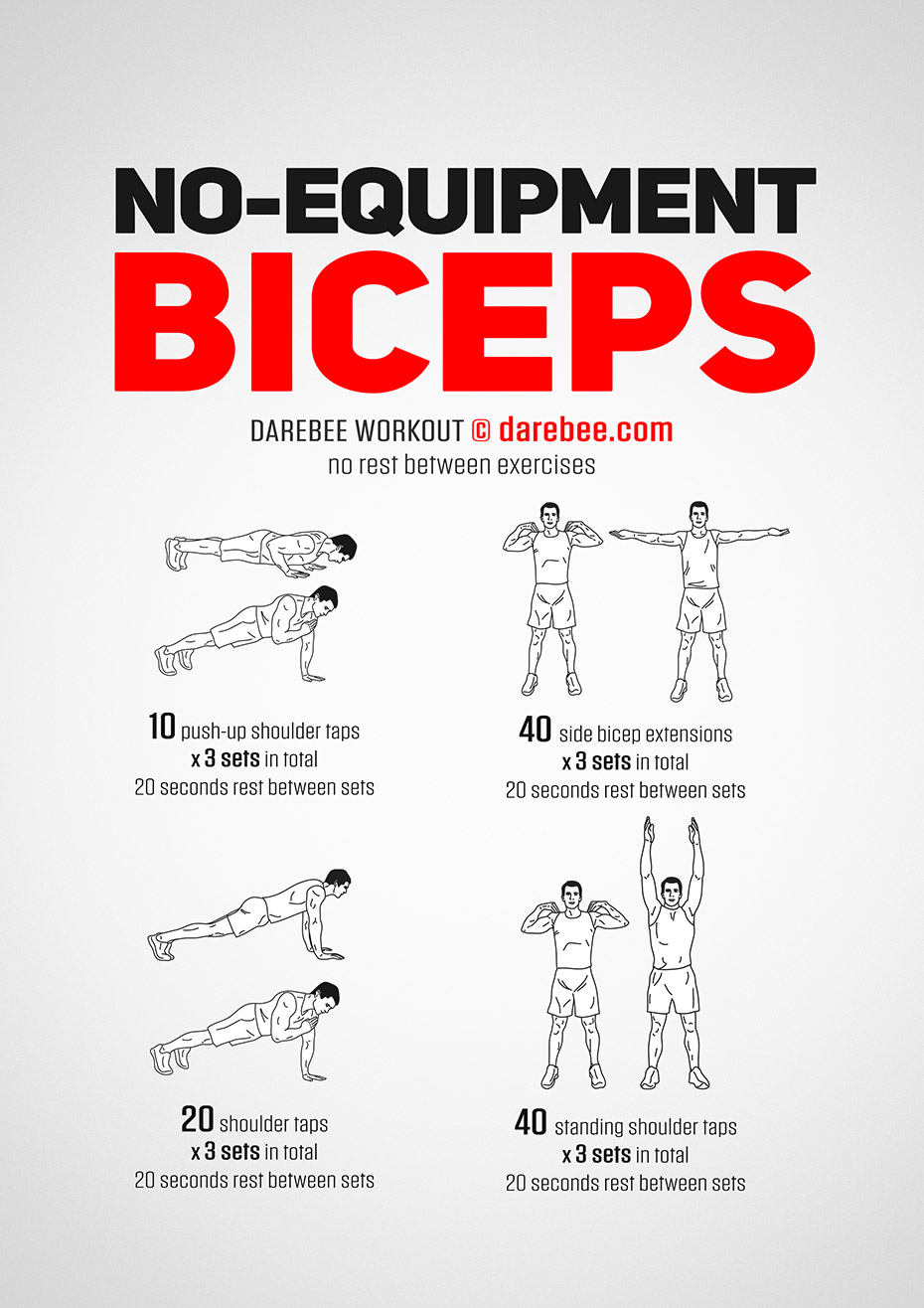Surprisingly, achieving toned biceps doesn’t always require lifting heavy weights. Many fitness enthusiasts have discovered that bodyweight exercises can be incredibly effective. This approach not only reduces the need for expensive equipment but also allows for greater convenience.
Historically, calisthenics, which use body weight for resistance training, date back centuries. Modern research supports the idea that exercises such as push-ups and plank variations can sufficiently target the biceps. In fact, studies show that consistency in these workouts can yield impressive gains in muscle definition and strength.

The Science Behind Biceps Training Without Weights
The Power of Resistance Training
Resistance training is essential for muscle growth. When muscles work against resistance, they experience small tears. The body repairs these tears, making the muscles stronger and larger.
Using your body weight can provide the necessary resistance. Push-ups and plank variations are excellent examples. They challenge your biceps effectively.
Body weight exercises also engage other muscle groups. This ensures a well-rounded workout. Plus, it promotes overall body strength.
Understanding Muscle Hypertrophy
Muscle hypertrophy is the process of muscle fibers getting bigger. This happens when muscles are subjected to stress, like during workouts. Over time, consistent stress leads to noticeable muscle growth.
Using body weight in your workouts can achieve this stress. The key is repetition and consistency. Ensure your muscles get enough rest between workouts for better results.
Different exercises target different parts of the biceps. Combining various moves can maximize hypertrophy. Experiment to find what works best for your body.
The Role of Progressive Overload
Progressive overload is crucial for continuous muscle growth. This means gradually increasing the workout’s intensity. It challenges your muscles, making them adapt and grow.
With body weight, you can modify exercises to increase difficulty. For example, move from knee push-ups to full push-ups. Another method is adding more repetitions or sets.
Tracking your progress helps in applying progressive overload. Use a workout journal or app. This keeps you on track and motivated.
The Benefits of Bodyweight Exercises
Bodyweight exercises offer several benefits. They are accessible and cost-effective as they require no equipment. You can perform them anywhere, anytime.
These exercises often engage multiple muscle groups at once. This provides a comprehensive workout. It enhances coordination and balance, too.
Bodyweight exercises also reduce the risk of injury. They promote natural movement patterns. Therefore, they are safer compared to lifting heavy weights.
The Importance of Exercise Technique
Good exercise technique is essential for maximizing benefits and preventing injuries. Proper form ensures that you are targeting the right muscles. This makes your workouts more effective.
Ignoring technique can lead to strain and potential injury. It can also result in wasted effort. Consistently practicing correct form builds muscle memory.
Correct Form for Maximum Gain
Proper form enhances muscle engagement. For instance, during push-ups, keeping your body straight works the biceps better. Maintaining a stable position ensures optimal muscle activation.
Using the correct technique also helps in hitting the muscle from different angles. This leads to balanced growth. Each muscle fiber is challenged uniformly.
Watching instructional videos or getting professional advice can help. Many online resources are free and easy to find. Consistency in following the correct form yields long-term benefits.
Avoiding Injury
Injury prevention is a key reason for practicing good exercise technique. Poor form can lead to strains, sprains, and other injuries. These setbacks can disrupt your fitness journey.
Warming up before starting your exercise helps. It prepares the muscles and reduces the risk of injury. Cooling down afterward is equally important.
Listening to your body is crucial. If you feel pain, stop and reassess your form. Rest and recovery are vital components of avoiding injury.
Building Muscle Memory
Muscle memory is developed through repetition of correct technique. This makes future workouts easier and more effective. Once good form becomes a habit, your performance improves.
Practice doesn’t always make perfect, but perfect practice does. Focus on quality over quantity. Aim for precise movements.
This principle applies to all exercises, not just biceps workouts. Always prioritize technique in your routine. Your body will thank you in the long run.
Dynamic Tension: An Underused Technique
Dynamic tension involves tensing muscles during exercise without external weights. It’s an effective way to build strength. This method uses your body’s resistance to challenge the muscles.
Tensing your muscles while performing movements, like bicep curls without weights, is key. This creates resistance internally. The result is increased muscle engagement.
Dynamic tension can be applied to various exercises. Bodybuilders often use this technique. It adds intensity to simple movements.
Incorporating dynamic tension into your routine has multiple benefits. It enhances muscle control. Plus, it can be done anywhere without any equipment.
- Increases muscle density
- Improves muscle awareness
- Reduces injury risk
Effective Body Weight Exercises for Bicep Training
Bodyweight exercises can be highly effective for bicep training. They offer significant resistance and promote muscle growth. No need for fancy equipment.
Push-ups are a versatile exercise for bicep training. Variations like diamond push-ups target the biceps more. Keeping your hands close together intensifies the workout.
Plank up-downs also engage the biceps. Move from a plank position to a push-up position. This dynamic movement builds strength.
Another excellent exercise is the inverted row using a sturdy table. Your biceps work hard to lift your body. It’s simple and effective.
Chin-ups, if you have a bar, are fantastic. Use an underhand grip to focus on the biceps. These are challenging but rewarding.
- Diamond Push-ups
- Plank Up-Downs
- Inverted Rows
- Chin-Ups with an Underhand Grip
Benefits of a Regular, Consistent Workout Schedule
A regular workout routine offers numerous health benefits. First, it boosts your overall fitness levels. Regular exercise enhances cardiovascular health.
Consistency in workouts leads to better muscle growth. This is because your muscles adapt to regular stress. Over time, you will notice improved strength and endurance.
Sticking to a schedule also helps in weight management. Regular exercise burns calories and improves metabolism. This results in maintaining a healthy weight.
Your mental health can improve with a consistent workout schedule. Physical activity releases endorphins, known as “feel-good” hormones. These hormones reduce stress and anxiety.
Finally, regular exercise enhances sleep quality. It helps regulate the sleep-wake cycle. Better sleep contributes to overall well-being.
- Boosts cardiovascular health
- Improves muscle strength and endurance
- Aids in weight management
- Enhances mental health
- Improves sleep quality
Integrating Biceps Workout in a Comprehensive Fitness Routine
Including biceps exercises in your fitness routine is vital. Balanced training ensures strength in all muscle groups. This prevents imbalances and injuries.
Variety keeps your workouts exciting and effective. Combine biceps exercises with routines targeting the chest, back, and legs. This offers comprehensive strength training.
Cardio is also essential in a well-rounded fitness plan. Activities like running or cycling boost endurance. Incorporating cardio improves overall health.
Flexibility exercises should not be overlooked. Practices such as yoga or stretching maintain muscle suppleness. They improve range of motion and reduce stiffness.
A good fitness routine also focuses on recovery. Adequate rest allows muscles to heal and grow. Proper nutrition supports this recovery process.
- Balanced strength training
- Variety in workouts
- Include cardio activities
- Don’t forget flexibility exercises
- Focus on recovery and nutrition
Key Takeaways
- Push-ups use body weight to build bicep strength.
- Diamond push-ups offer intense bicep engagement.
- Plank up-downs enhance both strength and stability.
- Inverted rows are effective for upper body workouts.
- Proper technique ensures safe and effective muscle growth.

Frequently Asked Questions
Below are some common questions about home biceps workouts without weights. These answers will help you better understand the techniques and benefits.
1. How can I prevent injury during bodyweight bicep exercises?
Preventing injuries starts with using proper form. Always warm up your muscles before starting any workout. This prepares your muscles for the stress they’ll undergo. Proper stretching at the end can also help prevent soreness and injury.
Avoid rushing through movements, as this can lead to poor form and accidents. Focus on controlled, deliberate actions with each exercise. Listen to your body; if something hurts, stop immediately.
2. Can bodyweight exercises really build bicep strength effectively?
Yes, bodyweight exercises can be very effective for building bicep strength. Exercises like push-ups and planks engage multiple muscle groups, including the biceps. These exercises create sufficient resistance for muscle growth when done correctly.
The key is consistency and progressively challenging yourself with variations of each exercise. Over time, you’ll notice significant improvements in your strength and muscle definition.
3. What are some common mistakes to avoid during these workouts?
A common mistake is neglecting proper form to complete more repetitions quickly. This leads to ineffective workouts and increases the risk of injury. Always prioritize quality over quantity.
Another mistake is not integrating enough variety into your routine. Doing the same exercise repeatedly can cause plateaus in progress. Mixing up exercises keeps your muscles challenged.
4. How often should I perform these workouts for best results?
A good frequency for home bicep workouts is 2-3 times per week. This schedule allows adequate rest between sessions, which is crucial for muscle recovery and growth.
Younger athletes or those new to exercising might start slower and gradually increase frequency as their fitness levels improve. It’s always important to listen to your body’s needs.
5. Are there specific signs that my technique needs improvement?
Pain or discomfort in joints instead of muscles usually indicates poor technique or form issues. Muscle strain should feel like a challenge but not sharp pain.
If you’re not seeing any progress despite regular workouts, this may suggest an issue with how you’re performing exercises. Seeking advice from a fitness professional or watching tutorial videos can help correct your form.

Conclusion
Effective biceps workouts at home without weights provide a convenient way to stay fit. Utilizing bodyweight exercises like push-ups and planks can yield substantial muscle growth. The key is consistency and proper form.
Integrating biceps exercises into a balanced fitness routine ensures overall strength and health. Remember, the benefits go beyond just physical gains. A regular, well-rounded workout regimen positively impacts mental well-being too.
